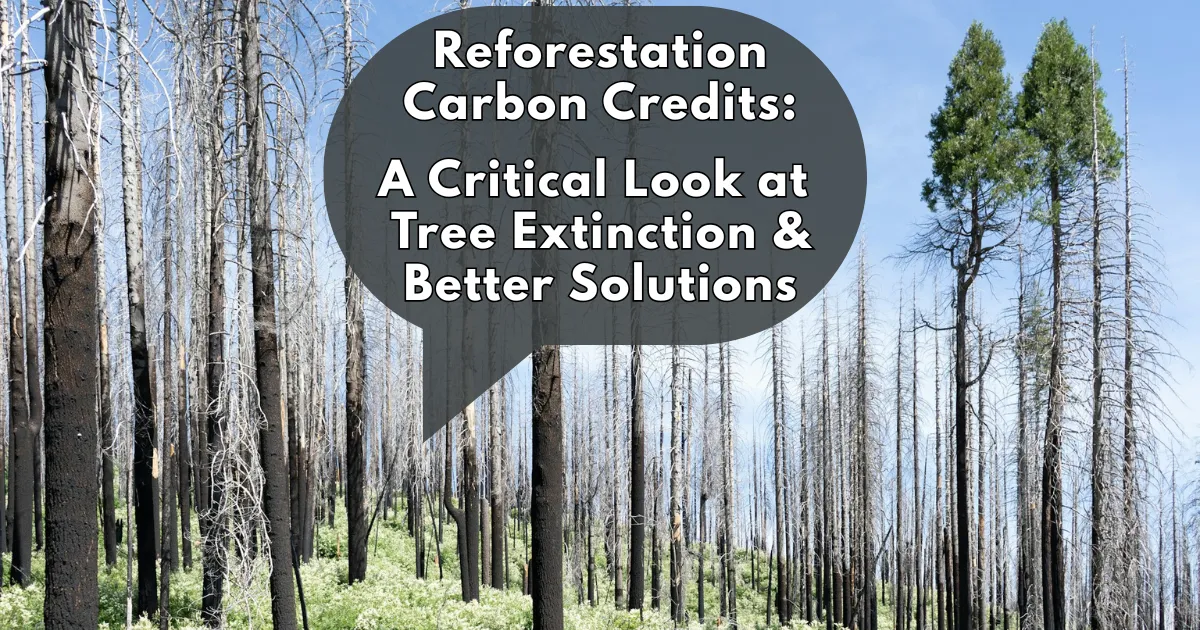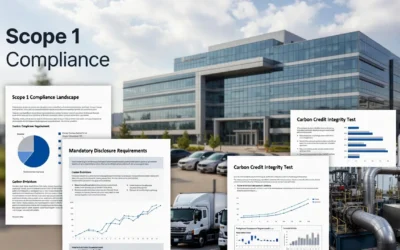While traditional reforestation carbon credits aim to combat climate change, they often fall short as tree species face extinction at alarming rates. Dynamic Carbon Credits offers superior alternatives through direct air capture via plants, biochar production, and regenerative agriculture, providing more permanent, transparent, and additional carbon removal with multiple ecological co-benefits.
Beau Parmenter
The Silent Crisis: Tree Species Extinction
While headlines about climate change dominate our news cycles, a parallel environmental catastrophe is unfolding with far less attention: the rapid extinction of tree species worldwide. According to the Botanic Gardens Conservation International’s State of the World’s Trees report, nearly one-third of the world’s tree species – about 17,500 species – are currently threatened with extinction. This represents twice the number of threatened mammals, birds, amphibians, and reptiles combined.
The causes are multifaceted: deforestation for agriculture and urban development, unsustainable logging practices, climate change-induced shifts in temperature and precipitation patterns, invasive pests and diseases, and wildfires of increasing frequency and intensity. In North America alone, we’ve already witnessed the functional extinction of the American chestnut and are watching the eastern hemlock and ash trees disappear from our forests due to introduced pests.
This biodiversity crisis creates a troubling paradox for traditional reforestation carbon credits. Many projects plant fast-growing monocultures – often non-native species – to maximize carbon sequestration rates. While these approaches may capture carbon in the short term, they fail to restore the complex forest ecosystems that provide resilience against climate change and support countless other species.
The Limitations of Traditional Reforestation Credits
Reforestation carbon credits face several critical challenges that limit their effectiveness as climate solutions:
Permanence Problems
Trees store carbon only as long as they remain standing and healthy. In an era of increasing climate instability, forests face growing threats from wildfires, drought, pest outbreaks, and extreme weather events. The devastating 2020 wildfires in California, for example, released more carbon than the state had reduced through all its climate policies in the previous 18 years, according to some estimates.
Dr. William Anderegg, a forest ecologist at the University of Utah, notes:
“We’re seeing forests that we thought were permanent carbon sinks turning into carbon sources overnight due to climate-driven disturbances. This fundamentally challenges our notion of forests as reliable climate solutions.”
Additionality Concerns
Many reforestation projects struggle with the concept of “additionality” – proving that the carbon sequestration wouldn’t have happened without the project. A 2020 analysis by CarbonPlan found that California’s forest carbon offsets program had issued credits for carbon that would have been stored regardless, resulting in emissions of up to 39 million tons of CO2 that weren’t actually offset.
Time Lag
Trees take decades to reach their full carbon sequestration potential. Given the urgency of our climate crisis, with the IPCC warning we must halve emissions by 2030, this time lag presents a significant challenge.
Measurement Uncertainties
Accurately measuring carbon sequestration in forests remains challenging. Variations in soil carbon, tree growth rates, and ecosystem dynamics create significant uncertainties in carbon accounting.
Dynamic Carbon Credits: A Better Approach to Carbon Removal
In the face of these challenges, Dynamic Carbon Credits has pioneered more effective, transparent, and ecologically sound approaches to carbon removal that address the fundamental limitations of traditional reforestation credits.
Direct Air Capture via Plants: Nature’s Original Carbon Technology
While technological direct air capture (DAC) solutions receive significant attention, Dynamic Carbon Credits recognizes that plants have been perfecting the art of carbon capture for over 400 million years. Through the process of biosynthesis, plants pull carbon dioxide directly from the atmosphere with remarkable efficiency.
Rather than focusing solely on tree planting, our approach leverages diverse plant communities—including native grasses, shrubs, and agricultural crops – to capture carbon. This distributed approach creates resilience against the threats facing monoculture forests and can be implemented across various landscapes, including agricultural lands that wouldn’t be suitable for reforestation.
“Plants are the original carbon capture technology,” explains Anna Jacobs, Chief Scientist at Dynamic Carbon Credits. “By working with nature’s time-tested systems rather than against them, we can achieve carbon removal that’s both more effective and more beneficial to local ecosystems and communities.”
Biochar: Turning Carbon Capture into Permanent Storage
One of the most innovative aspects of Dynamic Carbon Credits’ approach is our focus on biochar production. Biochar is created through pyrolysis – heating biomass in the absence of oxygen – which converts plant material into a stable form of carbon that can persist in soil for hundreds to thousands of years.
This addresses the critical permanence problem that plagues reforestation projects. While trees may burn or die, releasing their stored carbon, biochar represents a form of carbon removal that remains stable even in the face of climate change. Research from the International Biochar Initiative suggests that biochar can sequester carbon for 1,000+ years in soil, compared to the decades-long storage of living forests.
Additionally, biochar provides remarkable co-benefits when added to soil:
- Improved soil fertility and water retention
- Reduced need for synthetic fertilizers
- Enhanced crop yields and resilience
- Habitat for beneficial soil microorganisms
Regenerative Agriculture: Beyond Carbon Storage
Dynamic Carbon Credits also partners with farmers implementing regenerative agriculture practices that sequester carbon while rebuilding soil health. These practices include:
- Cover cropping to keep living roots in the soil year-round
- Reduced or no-till farming to minimize soil disturbance
- Diverse crop rotations that enhance soil biology
- Integrated livestock management that mimics natural grazing patterns
Unlike monoculture tree plantations, these approaches improve agricultural productivity while sequestering carbon, creating economic incentives for farmers to maintain these practices long-term. This addresses both the permanence and additionality concerns of traditional carbon credits.
A 2020 study in Scientific Reports found that farms using regenerative practices sequestered 3.5 metric tons of CO2 per hectare annually while simultaneously increasing profits by 78% compared to conventional farms. This win-win scenario creates genuine additionality, as farmers have economic incentives beyond carbon credits to maintain these practices.
The Three Pillars of High-Integrity Carbon Credits
Dynamic Carbon Credits builds its approach on three fundamental principles that ensure genuine climate impact:
- Additionality
Every credit we issue represents carbon removal that wouldn’t have occurred without our intervention. We achieve this by working with farmers transitioning to regenerative practices and developing biochar production facilities that wouldn’t be economically viable without carbon finance. - Permanence
Unlike reforestation projects vulnerable to reversal, our focus on biochar and soil carbon provides storage mechanisms that can last centuries to millennia. This long-term storage is verified through rigorous soil testing and monitoring protocols. - Transparency
We leverage advanced monitoring technologies and third-party verification to provide unprecedented transparency in our carbon accounting. Every credit can be traced to its source, with clear documentation of the carbon removal process and ongoing monitoring to ensure permanence.
Beyond Carbon: The Ecological Co-Benefits
While addressing climate change is urgent, we recognize that carbon removal solutions must also support broader ecological health. Our approach delivers multiple environmental benefits beyond carbon sequestration:
- Biodiversity enhancement: Our regenerative agriculture practices create habitat for pollinators, birds, and beneficial insects, supporting ecosystem health.
- Water quality improvement: Reduced synthetic inputs and improved soil structure minimize agricultural runoff and water pollution.
- Soil health restoration: Building organic matter in soils enhances their ability to support life and produce food.
- Climate resilience: Improved soil water retention helps farms withstand both drought and flooding events.
The Path Forward: Integrating Solutions for Maximum Impact
The extinction crisis facing tree species doesn’t mean we should abandon forest conservation – quite the opposite. We need urgent action to protect remaining forests and their biodiversity. However, we must recognize the limitations of reforestation carbon credits and develop more robust, diversified approaches to carbon removal.
Dynamic Carbon Credits represents this next generation of climate solutions – approaches that work with natural systems to enhance their carbon sequestration capacity while building resilience against climate change itself. By focusing on biochar production, regenerative agriculture, and diverse plant communities, we create carbon removal credits that are more permanent, more additional, and more beneficial to ecosystems than traditional reforestation approaches.
For corporations serious about their climate commitments, these high-integrity carbon credits offer a way to offset emissions while contributing to ecological restoration rather than simplistic tree planting schemes that may not survive the climate changes ahead.
As we face the dual crises of climate change and biodiversity loss, we need solutions that address both challenges simultaneously. Dynamic Carbon Credits is pioneering this integrated approach, creating carbon removal pathways that help stabilize our climate while supporting the complex ecosystems upon which all life depends.






